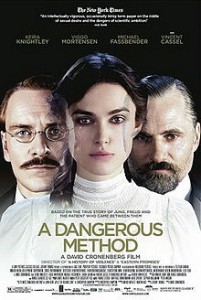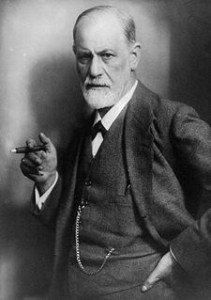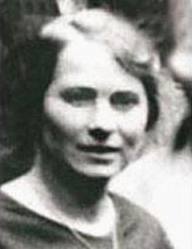 Most everyone is familiar with the psychologists Freud and Jung as well as Freud’s theory of dream analysis. However, the specific details of Freud and Jung’s medical treatment are not very well-known outside the actual field of psychology. I think that the relationship between the two men and the conditions of the times in which they emerged are also not well-known. This movie depicts Freud and Jung’s friendship and eventual falling out, as well as their relationship with their student, the female psychiatrist Sabina Spielrein.
Most everyone is familiar with the psychologists Freud and Jung as well as Freud’s theory of dream analysis. However, the specific details of Freud and Jung’s medical treatment are not very well-known outside the actual field of psychology. I think that the relationship between the two men and the conditions of the times in which they emerged are also not well-known. This movie depicts Freud and Jung’s friendship and eventual falling out, as well as their relationship with their student, the female psychiatrist Sabina Spielrein.
Sabina lived in the city of Rostov-on-Don in western Russia, born into a wealthy Jewish family. However, she was afflicted by mental illness, and in 1904, was admitted to a Swiss mental hospital, Burghölzli, in Zurich. Here she was treated by Jung, a young psychiatrist. Jung was the son of a Lutheran pastor, and had married a woman from a wealthy family; he was sincere, faithful in marriage, and blessed with good looks and intelligence, but also had a keen perception that was akin to a sixth sense. When they meet, Jung recognizes that Sabina also possessed this same kind of perception and exceptional intellect. Through Jung’s treatment, Sabina eventually recovers from her illness and starts medical school with the aim of becoming a psychiatrist.
 Jung becomes aware that Sigmund Freud is treating a patient with similar symptoms as Sabina using psychoanalysis, a method based on the theory of the subconscious that was innovative for its time, and the two become close friends around 1907. Freud is very fond of Jung and asks him to treat Otto Gross, an apprentice of Freud who was suffering from a mental illness. In the private sessions with Otto, Jung, a conformist and one who strictly adhered to monogamy, is greatly challenged by Otto’s depraved philosophy; eventually, out of the desire to be honest with himself, Jung admits his love for Sabina, and he and Sabina begin an affair. During the time of this affair, Sabina’s brilliant mind greatly influenced Jung’s theories.
Jung becomes aware that Sigmund Freud is treating a patient with similar symptoms as Sabina using psychoanalysis, a method based on the theory of the subconscious that was innovative for its time, and the two become close friends around 1907. Freud is very fond of Jung and asks him to treat Otto Gross, an apprentice of Freud who was suffering from a mental illness. In the private sessions with Otto, Jung, a conformist and one who strictly adhered to monogamy, is greatly challenged by Otto’s depraved philosophy; eventually, out of the desire to be honest with himself, Jung admits his love for Sabina, and he and Sabina begin an affair. During the time of this affair, Sabina’s brilliant mind greatly influenced Jung’s theories.
However, starting from around 1913, Jung and Freud have a falling out. Freud considers Jung’s love for the psychic ability to be occult and fears he is drifting too far away from the scholastic field of psychology; on Jung’s side, he becomes skeptical of Freud’s use of dream analysis to explain the whole nature of the subconscious. After that, the two become antagonistic within their field. At the same time, Sabina, now a fully-fledged psychologist, begins asking Jung if they could be more than lovers, and this causes Jung and Sabina’s relationship to fall apart as well. After Jung, the next person Sabina chooses as a mentor is Freud. Freud tells her that, as they are both Jewish, they’re able to understand each other well. However, after Sabina, Jung begins an affair with Toni Wolff, also Jewish. The film ends just before World War I when Jung and Freud part ways.
 The fact that Freud was Jewish makes the relationship between Jung and Freud very interesting. Freud and Jung were integral in the founding of the International Psychoanalytical Association in 1911, but Jung, not Freud, became the first president, and it is said Jung was chosen because the president of the association could not be a Jew. Freud was an Ashkenazi Jew (a Jew descended from Eastern Europe). In those days, it was difficult for Ashkenazi Jews to be researchers through university positions, so Freud earned a living as a common doctor of private practice while working hard on his research.
The fact that Freud was Jewish makes the relationship between Jung and Freud very interesting. Freud and Jung were integral in the founding of the International Psychoanalytical Association in 1911, but Jung, not Freud, became the first president, and it is said Jung was chosen because the president of the association could not be a Jew. Freud was an Ashkenazi Jew (a Jew descended from Eastern Europe). In those days, it was difficult for Ashkenazi Jews to be researchers through university positions, so Freud earned a living as a common doctor of private practice while working hard on his research.
Ashkenazi refers to Jews that reside in German-speaking areas or Eastern European countries. Sephardim refers to another group of Jews that resides in the Middle East. At first, the Ashkenazi Jews were traveling merchants that linked Islam to Europe. However, since direct trade between Europe and Islam became common practice and the long trip became dangerous for Jews because of Jewish persecution, the Ashkenazi shifted to being settled merchants and moved into the finance business, which was banned for Christians. The merchant in Shakespeare’s The Merchant of Venice is an Ashkenazi Jew. The Ashkenazi were expelled from Britain in 1290 and from France in 1394, thus immigrating to Eastern Europe. They were persecuted in the Holy Roman Empire, but since the social rights for Jews were guaranteed in the Kingdom of Poland since 1264 with the “Statute of Kalisz,” Poland was an extremely safe country for Jews to live in. The Kingdom of Poland also welcomed Jewish immigrants as skilled workers to enhance their economy. From Poland, Jewish people immigrated east to Ukraine and Russia.
When Adolf Hitler as the leader of the Nazis expelled Ashkenazi scholars from the psychiatric society in 1938, Jung, using his position as the president of this society and as a citizen of a permanently neutral country, planned to secure status for Ashkenazi doctors within Germany by accepting them into an international society. He asked Freud about his plan, but Freud rejected it by saying, “I can’t accept a favor from Jung, who is the enemy of my research.” Freud himself took refuge in London immediately after that, but the Ashkenazi doctors that were unable to take refuge lost work, and most were sent to concentration camps and murdered in gas chambers.
 As for Sabina, she married Russian Jewish doctor Pavel Scheftel in 1912, and lived in Berlin. They lived in Switzerland during World War I, but after the Russian Revolution in 1923, she returned to Russia under Soviet Union control and established a kindergarten in Moscow. However, in 1942, her hometown Rostov was invaded and she was murdered by Nazis.
As for Sabina, she married Russian Jewish doctor Pavel Scheftel in 1912, and lived in Berlin. They lived in Switzerland during World War I, but after the Russian Revolution in 1923, she returned to Russia under Soviet Union control and established a kindergarten in Moscow. However, in 1942, her hometown Rostov was invaded and she was murdered by Nazis.
